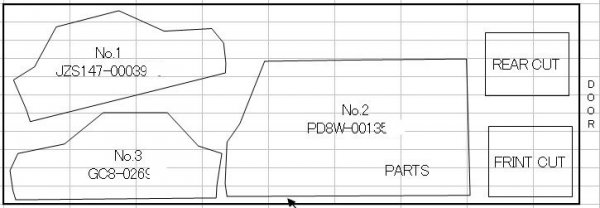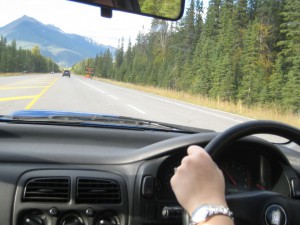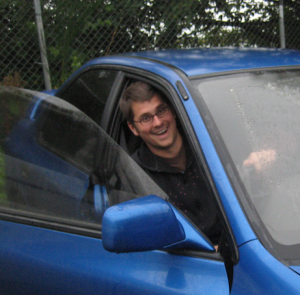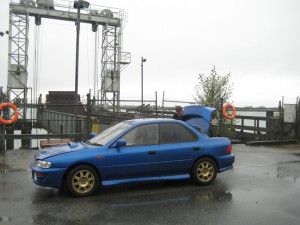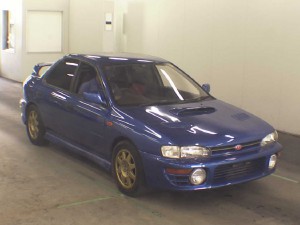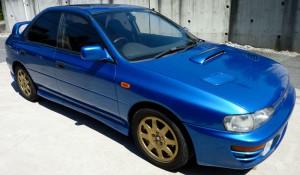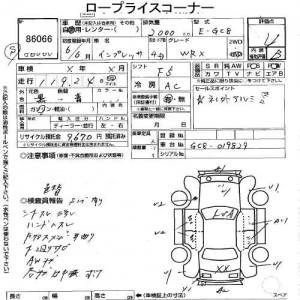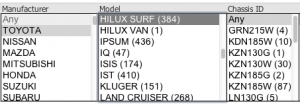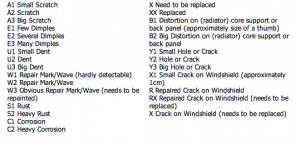Container Packing – Madman’s Tetris
It's pretty common knowledge that cars shipped from Japan didn't drive to their final destination. So, that means the car was shipped somehow.
When shipping cars from Japan, there is a 'stuffing' and 'destuffing' fee, which is a fee to get some one to put your car in, then later take your car out of a shipping container. The fee is a few hundred dollars both times.... now that seems like a lot.... Until you see what the containers look like when it's all said an done.
I took these images from Brave Auto's site (here and here - worth a read!) where they are discussing half cuts (a post on it's own). In short, one of the cars is cut in half in the container. You can see in the images that cars hang from ropes over other cars. This is to utilize all the possible space in the container to bring down the shipping costs per car.
While talking about container shipping cars, Mark at Brave Auto mentioned that it's generally easy to get the cars into the container, but quite difficult to get the cars OUT of the container without damaging them. This surprised me, but after thinking about it.... you're lowering a 2-3 ton car which is hanging dangerously close to other cars.... it's a recipe for disaster! So, Brave auto tries to leave room in the container even though another car could be shoehorned into the container. Doing this lowers the chances that a car is damaged while putting the cars in or taking the cars out.
My Import Story, A Summary
If you've been reading through my import story, you might be overwhelmed. Initially, its pretty frightening to say, "I'm going to buy a car that's on a different continent." And it probably should be.
In the end it's simple... well, simple enough. Here's the quick breakdown.
- Know what you want to buy, and how much you're willing to pay.
- Find an importer you like.
- Buy a car
- Pay for the car
- Ship the car
- Wait
- Wait
- Wait
- Clear the car through customs (probably with help)
- Drive the car home (don't forget temp insurance!)
- OOP/Safety your car
- Register your car
The end! The devil is really in the details. But for the best part, you deal with the problems as they come along.
Would I do it again? Heck yes. I still want a SWB Pajero TD and now I want a Suzuki Alto Works (badass kei car!), and I'll very likely get another minitruck one day. They're too useful to not have!
Importing is like getting a tattoo. It's really scary the first time, but you want to do it again as soon as possible.
My Import Story, Part 6
Apparently this turned into a huge series. This is the last chapter.
Getting your car home!
So, you've bought a car, shipped it, picked it up, and now you need to get it home. A few ways to do this. There are car carriers, but they tend to hate JDMs. Too bad. The fact they ship with no gas and usually have dead batteries when they get here doesn't help.
But, what most people do: have a great excuse for a road trip.
I only have one piece of advice for this part of the import process: In bold, and all caps. KEEP YOUR EYES ON THE OIL TEMPERATURE. I've heard of a few cars that have died 100km from their final destination. Due diligence would be to check your oil every time you fill up the tank, a good idea but a bit of overkill.
Getting your car insured
BC and Alberta require an OOP - Out of Province inspection. Other province might, but I don't know about that. Manitoba I do know about. Just a regular safety inspection will do. Your problem will be getting someone to look at your car, but that's a whole story on it's own. Compliance is also another story. Once day....
Paperwork you will need once you have your inspection completed:
- Something that says how much you paid for the car, so you can be taxed on it (again)
- Transfer of ownership documents with the address of the previous owner
- Deregistration from Japan
- Translated deregistration from Japan
- Your Form 1 from Transport Canada (saying it's been imported properly)
- Your completed safety
And that's really it. You're plated and ready to go! Congratulations.
Now this all sounds like quite a lot... but it's not. And it's worth it.
Next time: A summary, followed by a quiz.
My Import Story, Part 5
So. You've bought and paid for a car, cleared it though customs, now you want to pick it up. If you did all the work yourself, the car will be at the docks in a imported car common area. If you went through a bonded shipping agency, the car will be at their warehouse. Mine was the latter.
Before you even leave for the docks, you'll need temporary car insurance. Pretty simple to get. I forget which documents you need to get one. Probably the VIN/Chassis code for the car, and some proof that you own the car. In Manitoba you can get temporary insurance to only come into effect on a certain date.... so make it the day you get your car. Temporary insurance isn't cheap, so you probably don't want to pay for something you're not using.
This is what I looked like when I picked up my car:
That's a bit of an embarrassing photo. I think that everyone that picks up their car at the dock looks like that though. Below you'll see a picture of me filling the gas and doing the checks. The background you'll see what a prairie boy calls the ocean. That's awesome.
So, your car has been in shipping for about a month now. And you've never seen it in real life before. And if you're like me, you're about to drive it 2000km. You'd be an idiot to not check it out before you start driving it.
First off, these cars ship with the absolute minimum amount of fuel. Probably want to bring a jerry can of premium with you. Why premium? The gas is a bit old, and you don't know what they filled it with. Be nice to your car, it's the new kid in town.
Also, your battery might be dead, or lost its charged. Bring booster cables, or something to boost your car with.
Then, just some regular check.... here's what I did for a checklist.
- Fill up the tank.
- Check the oil
- Make sure there is coolant in the reservoir
- Make sure they're coolant in the radiator (remove coolant cap, make sure it's full)
- Try to start it... probably boost it.
- Let the car run... any weird sounds?
- Check brake fluid, move the car and make sure it stops (usually not an issue, but...)
- Check power steering fluid
- Make sure all lights work (especially brake lights). Again, not usually an issue, but you don't know.
- Check windshield wipers and washing fluid.
Am I pedantic? Yes. Have I seen this car before or know anything about it? No. They're all simple checks that can save you from a world of hurt later on into life. Just do it. Worst case scenario you can brag about how great your car was right off the boat.
Summary:
Bring temporary insurance, gas and booster cables. Bring oil, coolant, brake and washer fluid if you're feeling _really_ unlucky.
And there's still more. If you're most Canadians, you don't live in or around Vancouver. So, the ride home and insurance is coming up!
My Import Story, Part 4
So, you've bought a new car... you've paid for your new car, now for shipping.
Brave Auto (I sound like a broken record) does container sharing within the company. Four customers buy cars, and they get shipped out together. This is really one of the cheapest and safest routes to go. Again, Brave Auto uses 'CIF' purchasing, so the shipping is included.
With Brave Auto's container sharing, the containers go to a shipping yard to be unstuffed (the technical term).
Other routes to take are RO/RO - roll on, roll off. Basically, your car will be shipped with some other random cars that are around. Apparently it's a hotbed of theft.
However you ship it, you will need to get it though customs. Because it's 15 years old you can bypass the RIV process (and get an RHD because of that!), but it's still a good idea to get a customs clearing agency to do the work for you.
The things that need to be done for a 15-year old car are a little different than a RIV process car, thought some steps are similar.
You need to get a soil inspection. No foreign soil allowed into the country. They will send your car back for this. And you have to pay tax on it (for the first time), of course. And a border agency fellow has to come and look at it... make sure there's no people in the trunk, or anything crazy like that.
You'll dig through some paperwork, eventually ending in a 'Form 1', which is pretty much just Transport Canada saying that it's allowed through the border... they check the 'it's 15 years old' box, and it's done!
You'll end up with a stack of papers. These should include:
- The completed Form 1 (heck yes it's 15 years or older)
- A deregistration document in Japanese
- A translated deregistration document. That or you'll need to get it translated.
My Import Story, Part 3
We left off with a successful bid on a car! Congratulations! You now own a car that's on a different continent!
And the big reveal! I personally bid on and won a 1994 Subaru Impreza WRX! Meet Rex!
So, you own a car, and probably want to get it checked out. There's a few ways to do this. Some auction agents (J-cars, for instance) encourage you to get the car checked out before bidding on it (and charge for each car you get checked out). Not a bad idea. The problem is that some of the cars are super parked in, and can not be driven, so there are potential transmission problems. Auction agents that do the 'check out your car before purchase' often send the car straight to the ship... good and bad.
Mark at Brave Auto, on the other hand just doesn't let you bid on crap. Once you win, he brings your car into his shop and give it a very good once over, sending you about 100 photos of your new car. These photos are a little more representative of what you'll be receiving. He'll point out any knicks, dings and dents, and document them with photos. These are for your peace of mind, and for insurance purposes. Here's all the photos I got from Mark. Incredible completeness.
From here, you need to pay the rest of your money. I forgot to mention how to send money at the deposit phase. The best way, bar none, is Ken at Payline FX. He's courteous, and gets the best rates. If you're a credit union member (I am...) you can transfer money via Credit Union Direct, your CU's web interface. Super simple. There's a few hoops to jump through, you need to fill out a bunch of paperwork to prove you're you... but it's worth it.
That's it for this post. Next week, shipping and receiving!
My Import Story, Part 2
So, last week I talked about how to start importing a car, which really just starts with the dream of importing a car. This week, we move in to the real details.
Know somebody that knows somebody
I was lucky enough to know a few people that imported their cars, and they coached me on who to choose for an auction agent. Now, there's a lot of options here. Each auction agent runs their business a little differently, charging for different things. Also, some of the auction agents maybe aren't so hot at speaking/typing/communicating in English.
For instance, J-cars charges for rates for each car you bid on, charges an inspection fee, charges for inland freight (that's moving the car from the auction to the boat). This type of setup is quite confusing, but you only pay for what you use... so it could be cheaper to go this route.
I used Brave Auto International. The Director, Mark, is on jdmvip, ivoac and is.... British (I think)! I looked over a couple of options, and reviews of a few places... and Mark seems to run a tight ship, and really know what he's talking about. Note that I'm not getting paid to say this. Mark only does 'CIF' bidding (cargo, insurance, freight). Which brings us to the next point.
Know what you're paying for
I just said Brave Auto does CIF bidding... what that means is that 'everything' is included in your bid. So the bidding at Brave Auto includes:
- Buying the car
- Moving it to his shop (inland freight included)
- Having him look it over and send you ~100 photos
- Cleaning fee (no dirt allowed into Canada... if your car is dirty, they'll send it back!)
- Insurance on the boat
- Stuffing fee (putting it into a container... not as easy as you'd think)
- Pay the boat to actually take the car
You don't need to pay a bidding fee per car, but you also don't get to see EXACTLY how much you pay for the car. This is good and bad. Mark is not going to rip you off, but it's unclear how much you pay for what.
On the plus side, Mark tells you what he thinks of a car... without mincing words. Mark DOES NOT buy crap for you... this is worth a lot in the long run.
Also, Mark ships the cars he buys in his own containers.... not RO/RO (roll on/roll off). This means your car is safer from theft of your car, or stuff in your car.... or parts. Shipping is a thing of it's own... we'll get to that later.
Not all auction agents bid or ship this way. Some agents you will tell the bid for the car, then they'll charge you inland freight (moving the car to the boat), stuffing fees, insurance fees and cargo fees (that's paying the boat to take your car). This is fine, but you NEED to know what services are included before you just go and bid on a car.
Pay the man!
There's a lot of interest in cars, especially in importing really nice cars. All the bidding places are hammered with 14-year-olds with $100 that want to buy an R34 Skyline. The bidding agents need to know if you're serious. That's why all of them ask for a deposit. Usually the deposit is about $1000, but might be more if you're bidding on a seriously expensive car.
Know what you're bidding on!
The auction sheets are in Japanese.... not super useful if you don't speak Japanese.
There's still a lot of information you can glean from the datasheet, despite the fact you can't _actually_ read what it says.
There's more details here on this... and will probably be more later, as this is a HUGE part of the auction process.
Bidding Starto!
That might be 'bidingu starto'. Which is the broadcasted over the intercom in the actual auction houses.
Each auction is about.... a minute. So what you need to do is tell your auction agent what your MAXIMUM bid will be BEFORE the auction starts. Most ask for it hours in advance so they don't have to constantly be checking their email all day for last minute bids.
Remember to bid knowing what your auction fees will be. I always bidded CIF, so the amount I said would be the total amount I'd be paying to get it to the border in Vancouver. You may or may not have to pay more fees on top of this. Make SURE you know how much you're spending before you sign up to pay it.
When it's done, it's done
So, you've bid on a car and won! It's yours now. You're on the hook for the money. If you back out now, your auction agent is stuck with the car... and will be VERY grumpy. They can, of course, put it back on the auction and sell it... but they sure don't want to have to do that.
Next week... after you win!
rob
My Import Story, Part 1
If you follow this blog regularly, you'll know I recently imported a car from Japan. This is my story. I'll talk about how to import in general, then tell you how I went about it.
In the beginning...
I had owned my first right hand drive for about two years, and I wanted something a little more. My Hijet was cool and all, but I have family out-of-town that I should visit, and I just couldn't get myself to drive my itsy bitsy truck out that far. The Hijet could do highway, but it's like whipping a puppy to do it.
I had previously thought about importing something from Japan, but didn't have the nerve to do it. I even said to my wife, "I'd never import a car from Japan myself... that's way too much risk for me." Yeah. And that was my true feelings at the time.
Over time, my feelings changed about importing myself. People I've met (largely through this website) who have imported their own cars encouraged me, and helped me understand the risks, benefits and joy to be had when importing your own car.
So, with my little support group, a small pile of money and dreams of owning a 'new' car, I started the process.
Off to the races
Step 1... do your research.
Yes, hypothetically you could go to ebay.jp, buy a car and ship it. But you'd be stupid to do that. Know what you're getting into, and where to find the good cars.
In short, almost all the cars shipped to Canada from Japan come from the Japanese car auctions. It's Monday morning as I write this... and there's 64000 cars up for auction right now. Check out my previous posts How Auctions work, and Right hand drive auctions - a walkthrough for more details, but in short... the auctions last less than a minute each. It's nuts. In that minute, any car could sell, whether it's a $100000 Ferrari or a $100 minitruck... heck, I've seen rascal scooters on there (seriously... look under "Other", subgroup... "other").
Step 2... Know what you want
I'm guilty of not doing this. I was looking for a "AWD Turbo"... so.... Lancer EVOs, Imprezas, Hilux Surfs, Pajeroes, Legacies.... the list goes on. Not such a great idea.
So, know what vehicle you want, what body style, what colour (if you care), what 'grade' you want (we'll talk about that later), how many kms... and how much you want to pay. The last one is the hardest... again, later.
This is probably one of the hardest steps. The auctions are layed out in terms of Auto Maker->Car name->Chassis code... which is pretty confusing. Probably spend some time perusing the site before you start bidding... Really understand what you're looking at.
Next week... finding an auction agent and more!
Rob
Grey Imports – Canadians aren’t the only ones who do it
I found this quite interesting. CADA would have you believe that Canada is the only place in the world that imports cars from Japan. They even have called them 'dumping ground for unsafe vehicles'. So here we go, people in Britain do it too. Makes sense, both drive on the left side of the road, so it works quite well.
This is an old top gear episode, and the host is quite conservative, and the people are buying cars in a way I wouldn't. The cars in question in this video are bought without concern by an importer, and sold in an auction in the Ireland. Personally, I'd only buy a car I could test drive, or directly from Japan through an experienced auction agent. I don't think I'd trust someone who brings in a number of cars just to sell them off.
I think it's interesting how Top Gear approaches this problem. Yes - there _can_ be issues with these cars, and yes - they can be expensive to fix. But it has to be a calculated risk. You can get a much nicer car for a much nicer price in Japan, but you need to make sure you know what you're buying... like they say in the video, talk to someone who knows what they're talking about first.
I want to say the video is well-balanced, but it's not. They're a little too negative though the video, with just a note of "but they're not all that bad" at the end. Take it for what it's worth, since it's still quite interesting to see other people have the same discussions we have.
Without further delay:
rob
Learning how Auctions work
To bid on cars in Japan, you need an account with someone who has a bidding license. If you look back to the video walking through an auction house, you'll see that you need a special license to bid on the cars. There's a number of sites like this. Brave Auto international uses common software that's used to peruse the cars for sale, and J-Cars uses some other software.
On these site you'll see all the cars that are available to bid on. There are starting bids, and usually an average price shown to give you an idea what the car should go for. The average price is very misleading. The average price (depending on the site) is for cars of any grade that have approximately the same milage. Literally, that's cars that are new, to cars that have no front end. Ask your auction agent what the car you're looking for might usually go for. The datasheet shown is a WRX that's in great shape with 120000km, and the average price is says ~$400 which is totally off base.
What does it mean when a car doesn't sell? The starting bid has nothing in common with the seller's reserve price. Sometimes the reserve can be really high (higher than it should be?), but usually it's quite low.
All the cars in the auction are graded, but with varying degrees of negativity. The cars are graded out of 5, with 5 being the best. In general, you'll never see a 15 year old car with a grade greater than 4.
The exterior, and sometimes the interior, are then graded. The interior and exterior get a letter grade, from A to... D? I wouldn't go lower than a C, so I don't know.
The datasheet above is 4 B, which is a car in very good condition. The rest of the Datasheet changes from auction to auction. The 'car breakdown' is a very good way of discovering what kind of dings and dents the car has. The common markings can be seen in the picture to the left.
You'll need someone who speaks Japanese to translate the sheet for you. Some auction agents charge for this, some don't. If there's any uncommon markings on the sheet, the auction agent will (should) translate that for you too.
This is just an introduction... I'm sure there'll be more later! There's still shipping, which... well, is kind of a big deal when you buy a car on a different continent.
rob
